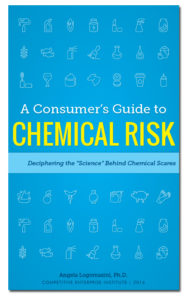Lots of claims about chemical risk are produced via statistical studies that only measure associations rather than cause-and-effect relationships. Therefore, the possibility that a factor other than the two variables in question is responsible for the result is always present. For example, a statistical analysis might find that people who spend a great deal of time in bars have a higher cancer rate. Does that mean that going to a bar can give you cancer? Probably not. Instead, it might be that smoking rates are higher among people who spend time in bars. Hence, smoking, not going to bars, would be the problem.
While scientists attempt to apply “controls” in studies in an effort to negate the impact of confounding factors, it does not always work. Some researchers admit it is not really possible. For example, researchers of a study reporting an association between the chemical Bisphenol A and obesity admitted that they could not control for the fact that the obese children may have a higher caloric intake from eating more processed food. BPA exposure comes largely from packaging for processed food, which tends to have higher calories. In that case, it is more likely that the real association they measured was between higher calories and obesity, with BPA being largely irrelevant.(1) But that is not what we read in the headlines.(2)
Researchers face a number of other challenges to establishing the validity of their findings. These include challenges associated with finding a truly random sample, sometimes insufficient sample size, recall bias, and, researcher bias.
Browse the terms on the sidebar of this webpage for more information and/or download a copy of A Consumer’s Guide to Chemical Risk: Deciphering the “Science” Behind Chemical Scares.
(1) Angela Logomasini, “Medical Junk Science: Canned Veggies May Make Kids Fat,” OpenMarket.org, October 3, 2012.
(2) For more background on confounding factors see: “What are Confounding Factors and How Do They Affect Studies?” Statistical Assessment Service (STATS), website, accessed August 20, 2013.


